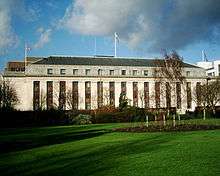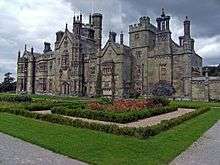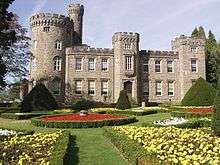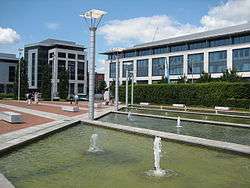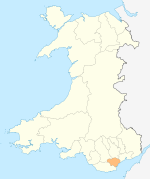Senedd
| Senedd | |
|---|---|
 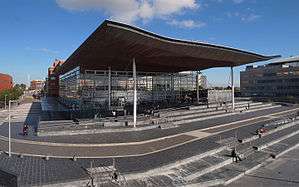 | |
| Alternative names | National Assembly building |
| General information | |
| Architectural style | Sustainable architecture, High-tech architecture |
| Location | Cardiff, Wales |
| Address | National Assembly, Cardiff. CF99 1NA |
| Coordinates | 51°27′50″N 3°09′43″W / 51.463901°N 3.162082°W |
| Construction started | 1 March 2001 |
| Completed | 7 February 2006 |
| Inaugurated | 1 March 2006 |
| Cost | GB£69.6 million |
| Owner | National Assembly for Wales |
| Technical details | |
| Floor count | 3 |
| Floor area | 5,308 square metres (57,000 sq ft) |
| Design and construction | |
| Architecture firm | Richard Rogers Partnership |
| Structural engineer | Arup |
| Services engineer | BDSP Partnership and MJN Colston |
| Main contractor |
Skanska (phase 1) Taylor Woodrow (phase 2) |
The Senedd (English: Senate or Parliament; Welsh pronunciation: [ˈsɛnɛð]), also known as the National Assembly building,[1] houses the debating chamber and three committee rooms for the National Assembly for Wales in Cardiff. The 5,308 square metres (57,100 sq ft) Senedd building was opened by Queen Elizabeth II on 1 March 2006 and the total cost was £69.6 million, which included £49.7M in construction costs. The Senedd is part of the National Assembly estate that includes Tŷ Hywel and the Pierhead Building.
After two selection processes, the decision was taken that the debating chamber would be on a new site, called Site 1E, at Capital Waterside in Cardiff Bay. The Pritzker Prize-winning architect Richard Rogers won an international architectural design competition, managed by RIBA Competitions, to design the building. It was designed to be sustainable with use of renewable technologies and be energy efficient. The building was awarded an "Excellent" certification by the Building Research Establishment Environmental Assessment Method (BREEAM), the highest ever awarded in Wales, and was nominated for the 2006 Stirling Prize.
The Senedd was constructed in two phases, the first in 2001 and the second from August 2003 until it was handed over to the National Assembly in February 2006. Between phases, the National Assembly changed contractors and the project's management structure, but retained Rogers as the scheme architect. The building was nearly six times over budget and four years and 10 months late, compared to the original estimates of the project in 1997. Total costs rose due to unforeseen security measures after the 11 September attacks, and because the National Assembly did not have an independent cost appraisal of the project until December 2000, three years after the original estimate. Phase 2 costs rose by less than 6% over budget, and that phase was six months late, due to information and communication technology (ICT) problems.
Architecture
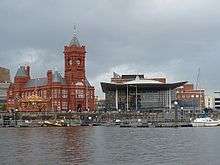
The Senedd building is in the former Cardiff Docks, about 3 kilometres (1.9 mi) south of Cardiff Castle. Cardiff Docks had been the largest coal-exporting port in the world, but by the 1980s with the decline of the south Wales coalfield, the area had gradually become derelict.[2] By the 1990s the area was being transformed with the construction of the Cardiff Bay Barrage and had been renamed Cardiff Bay.[3]
The building faces south west over Cardiff Bay, it has a glass façade around the entire building and is dominated by a steel roof and wood ceiling. It has three floors, the first and second floors are accessible to the public and the ground floor is a private area for officials. The building was designed to be as open and accessible as possible, the architects, the Richard Rogers Partnership (RRP) said "The building was not to be an insular, closed edifice. Rather it would be a transparent envelope, looking outwards to Cardiff Bay and beyond, making visible the inner workings of the Assembly and encouraging public participation in the democratic process."[4] The main area in the building is the debating chamber, called the Siambr, including a public viewing gallery. Other areas of the building are the Neuadd, which is the main reception area on the first floor and the Oriel on the second floor. The three committee rooms and the Cwrt are on the ground floor.[5]
Environmental features
The design criteria required sustainability, including a design life of 100 years, the use of local Welsh materials, minimal energy consumption and waste, the use of renewable technologies and for it to be an exemplar in terms of sustainability.[6]
In total, 36% of all materials and labour costs were spent in Wales, with approximately 1,000 tonnes (157,500 stone) of Welsh slate used.[7] The environmental features of the building have allowed energy savings of between 30% and 50% compared to buildings without these features. The features include 27 pipes that were drilled 100m below ground, so that during cold spells, water is pumped through the pipes and heated to 14 °C by geothermal energy.[8] The hot water is then pumped back up to the slate floor to warm the building to a constant temperature.[8] In warm spells, the same system helps to keep the building cool. A biomass boiler was installed to use wood chips from recycled waste wood to heat the building,[8] and rainwater is collected from the roof to flush the toilets in the building.[8]
Interior and contents
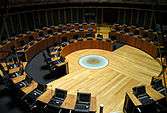
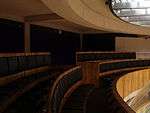
Y Siambr (Chamber; Welsh pronunciation: [/ˈʃambr/]) is a 610 m2 (6,600 sq ft) debating chamber, which holds all 60 Assembly Members (AMs) in a circular configuration under the cowl.[9] The Siambr can be increased to accommodate 80 AMs in the future, by removing temporary walls.[10] On the level above, is the public viewing gallery, which looks down on the debating chamber and is separated by security glass.[11] The public gallery holds 128 people on two rows of seats.[9] The AM's desks and public gallery seating are made of Welsh oak in a circular configuration so that all AMs can see each other, which, it is claimed, makes debating less confrontational.[12]
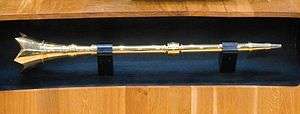
In front of the Presiding Officer's desk is the 1.3 metres (4.3 ft) ceremonial mace. Melbourne goldsmith Fortunato Rocca was commissioned by the Parliament of New South Wales in 2002 to design it. The mace took 300 hours to craft and is made from gold, silver and brass.[13] In 2006, it was worth around £10,500 (A$25,000) and was handed over to the National Assembly during the opening ceremony.[13]

All committee meetings are held in three committee rooms. Each can accommodate 24 people although committee rooms 1 and 2 can both hold 34 when fully opened. Members of the public can access the committee room viewing galleries from the Neuadd, which holds 31 people.[14]
Members of the public enter the building through Y Neuadd (Hall; Welsh pronunciation: [/ˈnəiað/]). This first floor level houses the public reception and information area. The reception desk features a large slate and glass desk and a canopy. Stairs to the left of the desk lead to the Oriel on the second floor.[15]
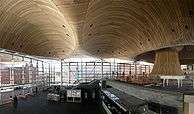
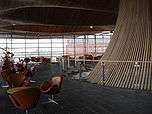
Yr Oriel (Gallery from Old French: Oriol;[16] Welsh pronunciation: [/ɔrjɛl/]) is a public sitting and exhibition area with views down to y Siambr and committee rooms. The glass flooring, which surrounds a large funnel feature, enables visitors to look down into the Siambr two floors below.[17] The Swan chairs selected for the Neuadd and Oriel areas were from Fritz Hansen, a Danish company, and originally designed by Arne Jacobsen in 1958.[18][19] Y Cwrt (Courtyard; Welsh pronunciation: [/ˈkʊrt/]) is an area on the ground floor with a members' tea room, a media briefing room, and access to the Siambr and committee rooms. It is accessible only to AMs, officials of the National Assembly and members of the press.[20]
An undulating ceiling made of Canadian-sourced Western Redcedar timber spans across the various sections of the building. It was manufactured and installed by BCL Timber Projects (sub-contracted by Taylor Woodrow).[21]
Artwork
.jpg)

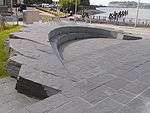
Four pieces of art were commissioned by the National Assembly to be both decorative and functional; they cost £300,000 in total. The Swansea based artist Alexander Beleschenko[22] designed and created the circular and domed Heart of Wales for the centre of the Siambr. It is 2 metres (6.6 ft) wide, made out of blue and gold glass, and lit from beneath.[23] Martin Richman designed and created 270 fabric-covered acoustic absorption panels, which were dyed and painted.[23][24] American sculptor Danny Lane designed and created the wind hedge, Assembly Field. It has five parallel rows of 32 glass plates and was designed to have the practical use of protecting the public from high winds coming off Cardiff Bay.[23] Devon born sculptor Richard Harris[25] created The Meeting Place on the Plinth, which is 45 tonnes of slate machine-cut into 39 slate slabs; the slate was from Cwt y Bugail Quarry in north Wales.[26] It is an informal seating area south of the building. Harris said of the work, "I wanted to create a space that was to the side of the building, that related closely to the building but was very inviting for people to use – somewhere quieter that people could sit and spend some time."[23]
Background and construction
First site selection process
Under the Laws in Wales Act 1536 Wales was fully incorporated into England and administered as a single sovereign state (the Kingdom of England) and legal system (English law).[27] It was not until 1964 that a Cabinet post of the Secretary of State for Wales was created, which gave some powers to Wales.[27] After the general election of 1997, the Labour Government published a white paper in July 1997, called A Voice for Wales; in it, the UK Government proposed that, "(the Welsh Assembly) headquarters will be in Cardiff ... (the) setting up (of) the Assembly is likely to cost between £12M and £17M. Additional running costs should be between £15M and £20M a year."[28] On 18 September 1997, Wales voted in favour of a National Assembly for Wales in the Welsh devolution referendum. The Government of Wales Act 1998 was passed by the Parliament of the United Kingdom, and was granted Royal Assent on 31 July 1998.[29]
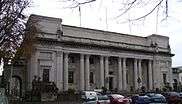 |
Before the referendum took place, the Welsh Office asked Symonds Facilities Management (later known as Capita Symonds) to investigate possible sites for a new Welsh Assembly.[30] The study was carried out in June 1997, and it considered 20 sites.[30] By August 1997, the Welsh Office and the Property Advisors to the Civil Estate (now part of the Office of Government Commerce), produced a shortlist of five sites for selection; the Cathays Park Building (the existing Welsh Office buildings), the Coal Exchange in Cardiff Bay, a site next to County Hall in Cardiff Bay, the former Glamorgan County Hall, Cathays Park and Cardiff City Hall, Cathays Park, owned by Cardiff Council.[30] In making their decision they considered the need for a space of 80,000 square feet (7,400 m2) that would be ready to use by May 1999. The building was to be of appropriate stature, location and quality, and provide good access for the disabled and good staff accommodation that would avoid disruption to existing staff.[30]
From the five on the shortlist, two sites were considered, the Cathays Park Building and Cardiff City Hall.[30] Cardiff City Hall was favoured because the executive and legislative functions would be separated, Cardiff City Hall was more widely recognised by the Welsh public and was a more prestigious building compared with the Cathays Park Building. The move to Cardiff City Hall would have also avoided a disruptive move for Welsh Office staff at the Cathays Park Building.[30] The Welsh Office concluded that Cardiff City Hall would only remain an option if the initial costs were £17M or less, which was the top end of the estimate figure given in the white paper. This would only be possible if essential works were carried out immediately and the remainder of the work carried out later. Cardiff Council would need to agree a selling price of £5M or less for this to be possible.[30]
Discussions took place between the leader of Cardiff Council, Russell Goodway, and the Secretary of State for Wales, Ron Davies, Member of Parliament (MP). The two disagreed on the valuation of the site, Davies offered what was believed to be the market price of GB£3.5M, Goodway demanded £14M for the relocation of Council staff.[31] In October 1997, both the Welsh Office and Cardiff Council agreed to the District Valuer providing an independent assessment of the market value of Cardiff City Hall and the cost of staff relocating to an equivalent standard of accommodation.[30] The District Valuer advised that the open market value of Cardiff City Hall was £3.5M.[30] There was not enough information available for the District Valuer to make a decision.[30] A bid of £2.5M was made by the Welsh Office on 14 November 1997, which was rejected on 21 November 1997.[30] A final offer of £3.5M was made on 24 November and this too was rejected by Cardiff County Council. Davies later announced his decision not to go ahead with the Cardiff City Hall site for the National Assembly.[30]
Second site selection process
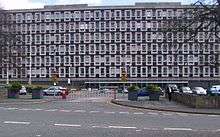
In December 1997, the Welsh Office invited proposals from Wales for the National Assembly building. 24 proposals were received,[31] 14 came from the private sector and government-owned corporations including HTV Group, Grosvenor Waterside (owned by Associated British Ports), Tarmac Developments, Cardiff Bay Development Corporation and Cardiff Airport.[30] Nine local authorities in Wales made proposals including the Guildhall proposed by Swansea Council, Cardiff City Hall by Cardiff Council, Margam Castle by Neath Port Talbot Council, Cyfarthfa Castle by Merthyr Tydfil Council, proposals also came from Wrexham Council, Flintshire County Council who proposed two sites at Ewloe and Mold, Rhondda Cynon Taf Council, Powys County Council and five sites from Bridgend Council[30] The Grosvenor Waterside proposal, known as Capital Waterside, included the Pierhead Building, Crickhowell House and Site 1E, which would become the site of the new debating chamber.
All the proposals were reviewed by the Welsh Office, who rejected sites due to poor location, accommodation or cost. A shortlist of ten sites were further reviewed, they were; Capital Waterside (now known as Cardiff Waterside), Cardiff City Hall, a site next to County Hall, Bute Square (now known as Callaghan Square), Prospect Place, Cardiff Gate Business Park, Kingsway and the Coal Exchange all in Cardiff, with the HTV site at Culverhouse Cross, and the Guildhall in Swansea.[30]
Davies announced on 13 March 1998 that the new National Assembly building would be in Cardiff.[30] He said that the Cardiff proposals were "too compelling to resist", because "in making this decision, I am mindful that Wales has invested 40 years in promoting Cardiff as our capital city."[31] The National Assembly building would be either in Bute Square or Capital Waterside.[30] The Welsh Office decided that the Capital Waterside proposal carried less risk and would cost less than the Bute Square proposal.[30] Capital Waterside would cost £43.9M, while Bute Square would cost £52.5M.[32] On 28 April 1998, Davies announced that the site of the National Assembly building would be Capital Waterside.[30] The site was acquired by the National Assembly from Grosvenor Waterside Investments Ltd, which was owned by Associated British Ports.[33] The agreement covered extending the lease of Crickhowell House, later known as Tŷ Hywel, until 2023, renting the Pierhead Building for 15 years and purchasing Site 1E for £1, which would be where the Senedd was built.[30]
Design selection process
Before deciding on Capital Waterside as the site of the National Assembly, Davies announced on 13 March 1998, that an international competition would be held to select the design of the building for the debating chamber. Royal Institute of British Architects (RIBA) Competitions would oversee the competition and a design panel would recommend a design to the Secretary of State for Wales.[30][34] The Design Competition Advisory Panel was made up of seven members and was chaired by Lord Callaghan of Cardiff, the former MP for Cardiff South and Penarth and Prime Minister of the United Kingdom. The chair and four members were appointed by Davies and the remaining two members were appointed by the RIBA. The competition was advertised in the Official Journal of the European Communities on 13 June 1998.[30]
Davies wanted a building "to capture the imagination of the Welsh people."[35] The criteria of the competition was that the building should have a functional specification and a price tag of no more than £12M including fees.[34] In total, 55 architects had shown interest in the project, nine came from Wales, 38 coming from the rest of the UK and the remaining eight from the rest of the world.[31] The Design Competition Advisory Panel selected 12 architects for interview in August 1998, from those a shortlist of six architects were chosen to submit concept designs, they were: Benson & Forsyth, Eric Parry Associates, Niels Torp and Stride Treglown Davies, Richard Rogers Partnership (now known as Rogers Stirk Harbour + Partners), Itsuko Hasegawa Atelier and Kajima Design Europe, and MacCormac Jamieson Prichard.[30]
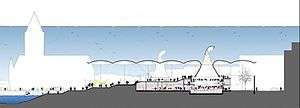
Each architect submitted designs by 5 October 1998,[30] 10 days later the Design Competition Advisory Panel met and unanimously recommended that the Richard Rogers Partnership (RRP) design should be selected.[30][31][34] Davies announced RRP as the scheme architects on 16 October 1998.[30] Richard Rogers said "The idea was that steps rise out of the water and there is a whole public domain where people meet each other and look down on the Assembly Members."[36] Richard Rogers had previously designed the Lloyd's building in London and the Pompidou Centre in Paris with Renzo Piano.[37] 11 days later, Davies resigned as Secretary of State for Wales.[38]
It was planned that the outline design would be completed by June 1999, and have a detailed design completed by February 2000. Construction of the building was due to begin in November 2000 and be completed in April 2001.[30] On 1 July 1999, The National Assembly for Wales (Transfer of Functions) Order 1999 came into effect, this transferred all powers from the Secretary of State for Wales to the National Assembly for Wales, responsibility for the construction of the debating chamber transferred at the same time.[29] Cardiff Council granted planning permission for the building on 8 November 1999 and by 26 January 2000 the National Assembly voted in favour of progressing the project onto the next stage.[29][39]
First phase of construction
Rhodri Morgan, Assembly Member (AM) replaced Alun Michael AM, to become the First Secretary (now known as the First Minister) of the National Assembly on 15 February 2000.[40] On 22 March, Morgan stopped all work on the project to carry out a complete review.[30] The decision to stop the project was supported by a vote in the National Assembly on 6 April 2000. The review included the costs and construction risks of the new building, the timetable for the completion of the project and consideration of possible alternatives to the new building.[30]
The review was carried out by the Assembly's Management Services Division, the Property Advisors to the Civil Estate and Symonds Group Ltd. They considered the following options, cancel the project, continue with the existing design, design a building on Site 1E, improve the existing debating chamber, construct a small one in the courtyard of Crickhowell House, and relocate to Cardiff City Hall.[30] On 21 June 2000 it was agreed that the original proposal using the RRP design should proceed.[41]

An international competition was held to select the main contractor. It was advertised in the Official Journal of the European Community, and in December 2000 Skanska Ltd was selected as the main contractor.[42] Edwina Hart AM, the Minister for Finance, Local Government and Communities, approved the final project design on 18 January 2001 and by 1 March 2001, the groundbreaking ceremony took place to mark the beginning of construction.[1]
Six months after construction had begun and with only the piling and a temporary road around the site having been completed,[39][43] Hart announced on 17 July 2001 that the National Assembly had terminated the contract of RRP. She said that despite the termination of the contract, the debating chamber should still be built to RRP's design.[44] RRP said of the project that "From the outset, RRP has advised that the project could not be built within a construction budget of £13.1M due to client changes, the political requirement to use indigenous materials at any cost and exceptional contractor changes. RRP's advice was consistently ignored. It is plainly untrue for the Finance Minister to assert that RRP underestimated the costs." Hart said she stopped the project because of the "significant underestimates in the cost plan prepared by RRP", and that RRP "had hidden costs from the Assembly".[45]
A legal dispute then arose between RRP claiming £529,000 in fees, and the National Assembly claiming £6.85M in damages.[46] On 10 December 2001 RRP requested an appointment of an adjudicator from the Construction Industry Council to resolve the issue.[47] The adjudication took place in February 2002, and ruled that RRP was entitled to £448,000 of its claim, while the National Assembly was not entitled to any of the damages they had claimed.[46]
Second phase of construction
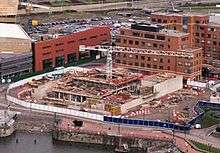
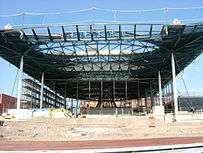
In August 2001, the National Assembly appointed Francis Graves Ltd as the project managers, to review the whole project up until the termination of the RRP contract and to propose how the project should progress in the future.[48] They reported that the "lines of accountability were complex and insufficiently clear", that no project costs were obtained by the National Assembly, independent of RRP, until December 2000,[48] and that the project "was highly susceptible to cost over runs".[48] The report recommended that the National Assembly appoint project managers, which they did when they appointed Schal International Management Ltd (part of Carillion) in May 2002.[48] Northcroft Group Ltd were appointed as a subcontractor, responsible for cost management and they reported directly to Schal.[48] Schal had full responsibility to manage the main contractor and subcontractors.[42] Schal reported to a Project Board, who reported to the Minister for Finance, Local Government and Communities.[48] The Project Board was made up of National Assembly and Welsh Government officials and a representative from Schal.[48]
The Welsh Government decided that a design and build fixed-price contract would be used for the second phase of construction, while phase one of construction made time the important factor over cost certainty.[48] The overall aim was to "deliver a landmark building…to time, to an appropriate quality and within budget".[48] On 23 October 2002 an invitation to tender was issued through the Official Journal of the European Community.[48][49] Eight companies submitted an interest in the tender process, including Taylor Woodrow, David McLean, Laing and Skanska,[50] of these only David McLean and the Taylor Woodrow Strategic Alliance Partnership with RRP as a subcontractor,[48] submitted tenders. David McLean's tender did not comply with the tender requirements, so the Assembly Government negotiated a fixed-price contract with Taylor Woodrow for £48.2M.[48] The contract was signed between Taylor Woodrow and the First Minister on 1 July 2003 and construction began for a second time on 4 August 2003.[51]
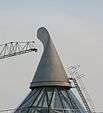
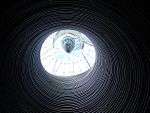
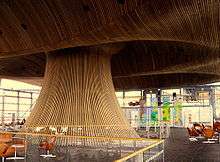
The topping out ceremony took place on 25 November 2004 by the Presiding Officer, Dafydd Elis-Thomas, Privy Counsellor (PC), AM, which included the lifting into place of the world's largest free rotating wind driven cowl, which was the tallest point of the building.[52] The cowl sits 6 metres (20 ft) above the roof line and rotates when the wind changes direction to ventilate the debating chamber.[53] Construction of the Senedd ended on 7 February 2006 when the National Assembly took control of the building.[48] The project was six months late, due to the National Assembly not producing a detailed specification on time.[48] The 10-year ICT contract, known as Merlin, was between the National Assembly and Siemens Business Services Ltd,[54] now known as Siemens IT Solutions and Services.[54][55] Other subcontractors on the project included Arup (structural engineers), BDSP Partnership and MJN Colston (services engineers),[56] and BCL Timber Projects (timber ceiling).[57]
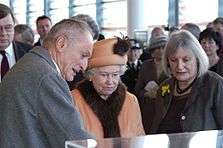
The 5,308 m2 (57,130 sq ft) Senedd building was opened by Queen Elizabeth II, the Duke of Edinburgh, the Prince of Wales and the Duchess of Cornwall on 1 March 2006 (St. David's Day).[58][59] After an address by the Queen, the Parliament of New South Wales presented a ceremonial mace to the National Assembly to recognise the links between Wales and New South Wales.[59] Addresses were later given by John Price MP, the Deputy Speaker of the New South Wales Legislative Assembly, Morgan and Elis-Thomas.[59] A set of commemorative envelopes and postmarks were issued by the Royal Mail to mark the opening of the Senedd, in the form of a souvenir sheet.[60]
Two years after the opening ceremony in 2008, Taylor Woodrow Construction were fined £200,000 and ordered to pay costs of £71,400, after being prosecuted by the Health and Safety Executive for breaching the Health and Safety at Work etc. Act 1974 at Cardiff Crown Court.[61] The breach contributed to the death of John Walsh, a foreman working for Ferson Construction Services Ltd, a subcontractor of Taylor Woodrow. The accident occurred on 14 March 2004 and was due to a cavity wall that Mr Walsh was filling, collapsing on him, even though Taylor Woodrow Construction had recognised the risks before the contract had begun. Judge Neil Bidder QC said "No-one seriously disputes it was an unsafe construction and Ferson (Construction Services) must share blame for that construction."[62]
Timeline of cost increases and time delays
The cost of the Senedd increased from £12M in 1997 to £69.6M in 2006, an increase of 580%. In a report published in March 2008 by the Wales Audit Office, the reason for the difference between the two costs were that the original estimate of £12M was not based on any detailed design of the final requirements of the building.[63] Extra costs of the building were due to unforeseen security measures after the 11 September attacks in the United States.[64]
After the project was stopped in 2001, the contract for the construction of the second phase of the building used a fixed-price design and build contract, which meant that the National Assembly had a much tighter control of costs than they had in the first phase.[63]
| Construction period |
Date | Cost | Estimated completion date |
Notes | ||
including selection processes |
July 1997 | c£12M | April 2001 | The first estimate by the Welsh Office in the A Voice for Wales white paper. | ||
| 16 October 1998 | £11.6M (total) £8.4M (construction) |
RRP estimated cost at time of the design selection process. | ||||
| January 2000 | £22.8M | Revised estimate by RRP after changes to the design of the building by the National Assembly. | ||||
| March 2000 | £26.7M | January 2003 | Estimate produced by Turner and Townsend for the National Assembly. | |||
| May 2001 | £37M – £47M (total) £28M (construction) |
Estimate from a 3-day workshop by the National Assembly and all contractors involved in the project. | ||||
| September 2001 | July 2004 | |||||
| January 2003 | £29.3M (construction) | Estimate from Taylor Woodrow, Schal and Northcroft, which was based on an incomplete design. | ||||
| 30 May 2003 | £41M (construction) | August 2005 | Tender submission by the Taylor Woodrow Strategic Alliance Partnership after value engineering. | |||
| July 2003 | £66.1M (total) £48.2M (construction) |
The final construction lump sum offer made by the Taylor Woodrow Strategic Alliance Partnership. | ||||
| 7 February 2006 | £69.6M (total) £49.7M (construction) |
Completion date | The total project cost, including £7.5M from phase 1. | |||
| 1 March 2006 (Royal opening ceremony) |
The project was 580% over budget compared with the original budget forecast in April 1997 (phase 1) and was four years and 10 months late. The project was 5.5% over budget from the lump sum offer made by Taylor Woodrow in July 2003 (phase 2) and was six months late due to ICT problems. | |||||
| Sources: National Audit Office Wales, Accommodation Arrangements for the National Assembly for Wales[30] and Wales Audit Office, The Senedd[48] | ||||||
In 2008, two years after the Senedd was opened, the cost of repairs to the building had reached £97,709. Repairs have been for windows, doors, plumbing and electrics. A spokesman for the National Assembly said, "The repair figures are not excessive for a public building that has hundreds of thousands of visitors each year. The costs are within estimated levels and covered by existing budgets."[65]
National Assembly estate in Cardiff Bay

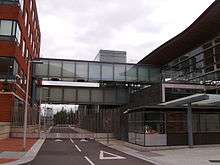
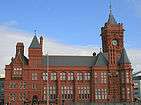
The Senedd is part of the National Assembly estate in Cardiff Bay, along with Tŷ Hywel (Howell House) and the Grade 1 listed Pierhead Building in Cardiff Bay.[66][67] Tŷ Hywel houses staff of the Assembly Commission, AMs, the First Minister and other ministers.[66][68] Tŷ Hywel is named after Hywel Dda (Howell the Good), King of Deheubarth in South West Wales.[68][69] On 26 June 2008, the Prince of Wales officially opened Siambr Hywel, the National Assembly's youth debating chamber and education centre.[70] It is based in the debating chamber that was used by the National Assembly between 1999 and 2006, while the Senedd was being constructed.[66][68][71] Two covered link bridges connect the Senedd to Tŷ Hywel. Construction of the link bridges began in September 2004 and they were completed by December 2005.[11][53][72]
The Pierhead Building was opened in 1897 and designed by William Frame.[73] It was originally the headquarters of the Bute Dock Company and by 1947 it was the administrative office for the Port of Cardiff.[74] The building was reopened in May 2001 as 'The Assembly at the Pierhead', which was a visitor and education centre for the National Assembly.[29] The exhibition provided visitors with information on the National Assembly.[75] On 1 March 2010, the building was again reopened to the public as a Welsh history museum and exhibition.[76] In 2008, Elis-Thomas announced that the Pierhead Building would display the history of the black community in Butetown, Cardiff Docks and Welsh devolution.[77]
Nominations and awards
Building
- Nominated for the 2006 Stirling Prize awarded by the Royal Institute of British Architects. The award was won by Terminal 4, Barajas Airport, Madrid, also an RRP design.[78]
- Nominated for the 2006 Prime Minister's Better Public Building Award.[79]
- Listed as Architects' Journal's top 50 favourite buildings.[80]
- Awarded "Excellent" certification by BREEAM, the highest ever awarded in Wales.[5]
- Awarded Major Project of the Year in the 2006 Building Services Awards, organised by Building Sustainable Design and Electrical and Mechanical Contractor magazines.[56]
- Awarded the 2006 Gold Medal winner from the National Eisteddfod of Wales.[81]
- Awarded the Slate Award in the 2006 Natural Stone Awards.[82]
- Awarded the 2006 Structural Steel Design Award.[83]
- Awarded the 2006 Excellence on the Waterfront from the Waterfront Center, in the category Commercial and Mixed Use.[84]
- Civic Trust Award winner in 2008.[85]
- Awarded a Chicago Athenaeum 2007 International Architecture Awards.[86][87]
Individual award
- Jeremy Williams (of Taylor Woodrow Construction) won the Construction Manager of the Year Award in 2006 for his work on the Senedd by the Society of Professional Engineers.[88] He also won a gold medal in the New Build/Refurbishment Projects Over £25 million category.[88]
See also
- Politics of Wales
- Senedd on television
- Cost overrun
- Owain Glyndŵr's Parliament House (Senedd-dy Owain Glyndŵr)
Notes
- 1 2 "Groundbreaking ceremony for new National Assembly building". National Assembly for Wales. Retrieved 2009-07-19.
- ↑ "Cardiff Bay". Cardiff Council. Retrieved 2010-03-07.
- ↑ "Walk printout". BBC. Retrieved 2010-03-05.
- ↑ "The National Assembly for Wales". Rogers Stirk Harbour + Partners. Retrieved 2009-06-28.
- 1 2 "National Assembly for Wales" (PDF). Department for Environment, Food and Rural Affairs. Retrieved 2009-05-03.
- ↑ "Sustainability". National Assembly for Wales. Retrieved 2009-04-18.
- ↑ "'No hiding place' in Senedd". Media Wales. Retrieved 2009-06-01.
- 1 2 3 4 "The Senedd – working with the environment" (PDF). National Assembly for Wales. Retrieved 2009-04-18.
- 1 2 "Y Siambr". National Assembly for Wales. Retrieved 2009-05-03.
- ↑ "Virtual Tours". National Assembly for Wales. Retrieved 2009-06-07.
- 1 2 "Project History 2005". National Assembly for Wales. Retrieved 2009-04-16.
- ↑ "Frequently Asked Questions". National Assembly for Wales. Retrieved 2009-06-28.
- 1 2 "New mace is gift from down under". BBC. 1 March 2006. Retrieved 2008-09-09.
- ↑ "Committee Rooms". National Assembly for Wales. Retrieved 2009-05-03.
- ↑ "Neuadd". National Assembly for Wales. Retrieved 2009-05-03.
- ↑ "Webster's Revised Unabridged Dictionary (1913 + 1828) page 1012". University of Chicago. Retrieved 2009-07-22.
- ↑ "The Oriel". National Assembly for Wales. Retrieved 2009-05-03.
- ↑ "The Swan designed by Arne Jacobsen" (PDF). Fritz Hansen A/S. Retrieved 2009-06-01.
- ↑ "Making Statements number 1" (PDF). Fritz Hansen A/S. Retrieved 2009-06-01.
- ↑ "Cwrt". National Assembly for Wales. Retrieved 2009-05-03.
- ↑ "Timber ceilings: National Assembly for Wales, Cardiff". BCL Timber Projects Ltd. Retrieved 2010-07-23.
- ↑ "Artist's fury over dumped sculpture". BBC. 8 May 2002. Retrieved 2009-05-28.
- 1 2 3 4 "Art chosen for new Welsh assembly". BBC. 17 May 2005. Retrieved 2009-04-30.
- ↑ "Colour in the Senedd – The Acoustic Panels". National Assembly for Wales. Retrieved 2009-07-01.
- ↑ "Richard Harris". Cass Sculpture Foundation. Retrieved 2009-05-28.
- ↑ "The Meeting Place on the Plinth". National Assembly for Wales. Retrieved 2009-07-01.
- 1 2 "The Government of Wales Act 2006: the challenges for legal education". University of Warwick. Retrieved 2010-03-05.
- ↑ "A Voice for Wales – The Government's Proposals for a Welsh Assembly". Royal College of General Practitioners. Retrieved 2009-04-08.
- 1 2 3 4 "Key Events in the Development of the National Assembly for Wales". National Assembly for Wales. Retrieved 2009-04-13.
- 1 2 3 4 5 6 7 8 9 10 11 12 13 14 15 16 17 18 19 20 21 22 23 24 25 26 27 28 29 30 31 "Accommodation Arrangements for the National Assembly for Wales" (PDF). Wales Audit Office. Retrieved 2009-04-08.
- 1 2 3 4 5 "Building a new assembly". BBC. 6 April 1999. Retrieved 2009-04-06.
- ↑ "Written Questions answered from 30 September to 7 October 1999" (PDF). National Assembly for Wales. Retrieved 2010-03-05.
- ↑ "The National Assembly for Wales (Transfer of Property, Rights and Liabilities) Order 2007". Office of Public Sector Information. Retrieved 2009-02-10.
- 1 2 3 "Project History 1998–2001". National Assembly for Wales. Retrieved 2009-04-06.
- ↑ Quotation is the BBC's summary of Davies' position. "Building a new assembly". BBC. 6 April 1999. Retrieved 2009-04-06.
- ↑ "New assembly building opens doors". BBC. 1 March 2006. Retrieved 2009-05-24.
- ↑ "Interviews". BBC. Retrieved 2009-05-10.
- ↑ "Secretaries of State". Wales Office. Retrieved 2010-03-07.
- 1 2 "Statement on the New Assembly Building". National Assembly for Wales. Retrieved 2009-04-13.
- ↑ "Morgan leads Welsh Assembly". BBC. 15 February 2000. Retrieved 2009-07-26.
- ↑ "The New Assembly Building". National Assembly for Wales. Retrieved 2009-04-15.
- 1 2 "The Holyrood Building Project" (PDF). Scottish Parliament. Retrieved 2009-04-16.
- ↑ "Project History 2001". National Assembly for Wales. Retrieved 2009-04-13.
- ↑ "The New Assembly Building" (PDF). National Assembly for Wales. Retrieved 2009-04-15.
- ↑ "Rogers rejects assembly HQ verdict". BBC. 18 July 2001. Retrieved 2009-04-15.
- 1 2 "The National Assembly's new building: update report" (PDF). National Assembly for Wales. Retrieved 2009-04-16.
- ↑ "The National Assembly's new building: Update report" (PDF). National Audit Office Wales. Retrieved 2009-04-16.
- 1 2 3 4 5 6 7 8 9 10 11 12 13 14 15 "The Senedd – Report presented on 12 March 2008" (PDF). Wales Audit Office. Retrieved 2009-04-16.
- ↑ "Project History 2002". National Assembly for Wales. Retrieved 2009-04-16.
- ↑ "Tenders for Welsh Assembly hit delays". Construction News (EMAP). Retrieved 2009-04-16.
- ↑ "Project History 2003". National Assembly for Wales. Retrieved 2009-04-16.
- ↑ "Historic day for new Assembly debating chamber". National Assembly for Wales. Retrieved 2009-04-26.
- 1 2 "The National Assembly for Wales" (PDF). University of Cincinnati College of Design, Architecture, Art, and Planning. Retrieved 2009-06-28.
- 1 2 "The Merlin Contract – Enabling the National Assembly to change its business processes through ICT" (PDF). Wales Audit Office. Retrieved 2009-06-06.
- ↑ "Welcome to Siemens IT Solutions and Services". Siemens. Retrieved 2009-06-07.
- 1 2 "National Assembly for Wales". MJN Colston. Retrieved 2009-05-09.
- ↑ "Timber ceilings". Barrett Ceilings Ltd. Retrieved 2009-05-09.
- ↑ "National Assembly for Wales". Rogers Stirk Harbour + Partners. Retrieved 2009-05-31.
- 1 2 3 "Official Opening of the Senedd". National Assembly for Wales. Retrieved 2009-04-16.
- ↑ "The Opening of the National Assembly for Wales Building Miniature Sheet – 1 March 2006". Norvic Philatelics. Retrieved 2009-06-25.
- ↑ "Taylor Woodrow prosecution highlights construction dangers". Health and Safety Executive. Retrieved 2009-06-01.
- ↑ "£200k fine in Senedd death case". BBC. 18 December 2008. Retrieved 2009-06-01.
- 1 2 "Assembly's Senedd building 'delivered on time and budget'". Wales Audit Office. Retrieved 2009-04-30.
- ↑ "Senedd is expensive, yes. But final iconic result is worth it". Media Wales. Retrieved 2009-06-14.
- ↑ "£100k repairs for Senedd... just 2 yrs on". Trinity Mirror. Retrieved 2009-06-25.
- 1 2 3 "Annual Report and Statement of Accounts of the Assembly Commission: 2007–08. Our Estate". National Assembly for Wales. Retrieved 2009-05-28.
- ↑ "National Assembly for Wales Commission Equality Scheme, Access to our Information, Proceedings and Buildings". National Assembly for Wales. Retrieved 2009-07-04.
- 1 2 3 "New name for Assembly former home". Media Wales. Retrieved 2009-05-28.
- ↑ "Laws of Hywel Dda". British Library website. Retrieved 2009-07-05.
- ↑ "Diary Entry Thursday 26th June 2008". Charles, Prince of Wales website. Retrieved 2009-07-01.
- ↑ "Annual Report and Statement of Accounts of the Assembly Commission: 2007–08". National Assembly for Wales. Retrieved 2009-07-01.
- ↑ "Project History 2004". National Assembly for Wales. Retrieved 2009-04-16.
- ↑ "Cardiff Bay". BBC. Retrieved 2009-05-04.
- ↑ "Cardiff Bay – Pierhead". BBC. Retrieved 2010-03-07.
- ↑ "Assembly visitor centre unveiled for the first time". National Assembly for Wales. Retrieved 2009-05-04.
- ↑ "Historic Pierhead building in Cardiff re-opens". BBC. 1 March 2010. Retrieved 2010-03-01.
- ↑ "New plans for Pierhead building". Media Wales. Retrieved 2009-10-02.
- ↑ "Royal Institute of British Architects (RIBA) Stirling Prize 2006 – Shortlist". Channel 4. Retrieved 2009-05-03.
- ↑ "Prime Minister's Award Winner and Finalists 2006". Commission for Architecture and the Built Environment. Retrieved 2009-05-03.
- ↑ "Building of the Year: The RIBA Stirling Prize 2009". Channel 4. Retrieved 2009-05-03.
- ↑ "National Assembly for Wales" (PDF). Design Commission for Wales. Retrieved 2009-05-24.
- ↑ "National Assembly for Wales" (PDF). QMJ Publishing Ltd. Retrieved 2009-05-24.
- ↑ "Structural Steel Design Awards 2006". Corus Group. Retrieved 2009-05-24.
- ↑ "The Waterfront Center announces winners of the 2006 "Excellence on the Waterfront" Program". The Waterfront Center. Retrieved 2009-05-24.
- ↑ "National Assembly for Wales". Civic Trust. Retrieved 2009-06-28.
- ↑ "2007 International Architecture Awards". Metropolitan Art Press, Ltd. Retrieved 2010-01-04.
- ↑ "RRP wins two Chicago Athenaeum Awards". Rogers Stirk Harbour + Partners. Retrieved 2010-01-04.
- 1 2 "The Senedd" (PDF). Society of Professional Engineers. Retrieved 2016-11-15.
External links
| Wikimedia Commons has media related to Senedd. |
- The Senedd on the National Assembly for Wales website
- The Senedd on the Rogers Stirk Harbour + Partners website
- The Senedd on the Arup website
- The National Assembly for Wales on the BBC website
- Live feeds from the Senedd
- National Assembly for Wales at Structurae
